|
 Secure Site
Secure Site
|
 |
Archive for the 'Bamboo Chime Clocks' Category
 set you mental alarm clock Determine what time you need to wake up.
Scientists have discovered that about an hour before a person expects to wake up, the body begins releasing a relatively high concentration of the hormone adrenocorticotropin into the blood. They believe that this may prepare the person to wake up. If this is true, you need only prompt the release of this hormone at the right time.
An alternative to shocking alarm clocks is the Zen Alarm Clock with Gentle Chime Sequence. The Zen Clock features an alloy chime bar similar to a wind chime. When the clock’s alarm is triggered, its chime produces a long-resonating, beautiful acoustic tone reminiscent of a temple gong. Then, as the ring tone gradually fades away, the clock remains silent until it automatically strikes again three minutes later.
The frequency of the chime strikes gradually increase over ten-minutes, eventually striking every five seconds, so they are guaranteed to wake up even the heaviest sleeper. This gentle, ten-minute “progressive awakening” leaves users feeling less groggy, and even helps with dream recall.
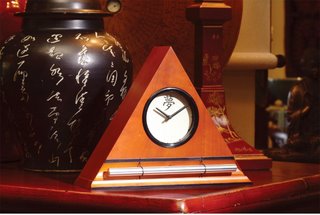 Summon Your Consciousness Awake Gently Now & Zen Clock Headquarters
1638 Pearl Street
Boulder, CO 80302
(800) 779-6383
Posted in Bamboo Chime Clocks
 sleeping outside, a perfect place for dream time... There’s something irresistibly romantic about sleeping outside. Long a part of cowboy and camping traditions, it achieved architectural expression in the late 19th and early 20th centuries with the rise of the sleeping porch. The idea continues to evolve. Whether used for a daytime catnap or a full night’s rest, open-air sleeping platforms can give you a chance to enjoy summer weather to the fullest.
Garden sanctuary
As a child, Marni Leis wanted a backyard playhouse. She realized her dream as an adult by building what she calls her “teahouse.” The 6- by 13-foot screened pavilion occupies a wooden platform near a small pond. Gauzy curtains frame the entrance and provide privacy and bug protection when needed. A shallow gabled roof covered with translucent fiberglass shelters the area from rain and drizzle without blocking the light. A portable Digital Zen Alarm Clock sits on a basket table by the futon bed on the platform bed.
She furnished the space with comfortable, stylish pieces, including a chair found at a flea market, an old coffee table, and an antique bookcase. “I used fabrics I could wash easily, because they are exposed to the elements,” she says. “I also used pieces that meant something to me. These give the place an air of nostalgia. When you’re there, you feel like you could be in another time or place. It’s great to get outside away from the noise and be alone with nature.”
Boulder, Colorado—an innovative company has taken one of life’s most unpleasant experiences (being startled awake by your alarm clock early Monday morning), and transformed it into something to actually look forward to. “The Zen Alarm Clock,” uses soothing acoustic chimes that awaken users gently and gradually, making waking up a real pleasure. Rather than an artificial recorded sound played through a speaker, the Zen Clock features an alloy chime bar similar to a wind chime. When the clock’s alarm is triggered, its chime produces a long-resonating, beautiful acoustic tone reminiscent of a temple gong. Then, as the ring tone gradually fades away, the clock remains silent until it automatically strikes again three minutes later. The frequency of the chime strikes gradually increase over ten-minutes, eventually striking every five seconds, so they are guaranteed to wake up even the heaviest sleeper. This gentle, ten-minute “progressive awakening” leaves users feeling less groggy, and even helps with dream recall.
adapted from Sunset Magazine by Mary Jo Bowling
 Digital Zen Alarm Clocks, for a calm awakening Now & Zen’s Gentle Chime Alarm Clock Store
1638 Pearl Street
Boulder, CO 80302
Posted in Bamboo Chime Clocks, Chime Alarm Clocks, Japanese Inspired Zen Clocks, Natural Awakening, Now & Zen Alarm Clocks, Progressive Awakening, Sleep Habits
 sleeping lady on coach Wean yourself off the alarm clock. After as little as a week of using a regular bed time and wake-up time, you should be able to wake up at about the correct time without your alarm. The more consistent your schedule is, the better, but even if you occasionally go to bed later or earlier than your usual time since you want to watch tv, your body should still feel ready to get up at your set time.
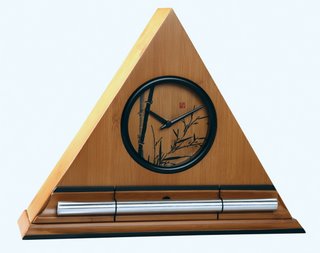 Try Using a Chime Alarm Clock for a Gentle Wake Up Or another suggestion might be to get the gentle, soothing chime alarm clock from Now & Zen, Inc. called The Zen Alarm Clock. The Bamboo Zen Clock’s long-resonating Tibetan bell-like chime makes waking up a beautiful experience – its progressive chimes begin your day with grace. When the clock’s alarm is triggered, the acoustic chime bar is struck just once … 3-1/2 minutes later it strikes again … chime strikes become more frequent over 10 minutes … eventually striking every 5 seconds until shut off. As they become more frequent, the gentle chimes will always wake you up – your body really doesn’t need to be awakened harshly, with a Zen Clock you’re awakened more gradually and thus more naturally.
 Chime Alarm Clock Store, Boulder, Colorado Now & Zen Chime Alarm Clock Shop
1638 Pearl Street
Boulder, CO 80302
(800) 779-6383
Posted in Bamboo Chime Clocks, sleep
 Combing beauty by Goyou, 1920 When you wake up anyway
Despite all your best efforts, here you are, awake at an hour even a fisherman would call ungodly. What do you do now? First, here’s a big don’t: “If you open your eyes and see the clock, that’s it for many stressed people,” Dr. Walsleben says. “Seeing the time can trigger them to become fully awake.” Keep your eyes closed, roll over, or move the clock so the display isn’t visible.
If you’re still far from dreamland try a mantra. Silently repeat any word that’s soothing or pleasant to you, or simply think “inhale” as you inhale “exhale” as you release your breath. Thinking the words over and over focuses and relaxes you, but requires less energy and attention than counting sheep, which can actually be too engaging to work the way it’s supposed to.
Rather than an artificial recorded sound played through a speaker, the Zen Clock features an alloy chime bar similar to a wind chime. When the clock’s alarm is triggered, its chime produces a long-resonating, beautiful acoustic tone reminiscent of a temple gong. Then, as the ring tone gradually fades away, the clock remains silent until it automatically strikes again three minutes later. The frequency of the chime strikes gradually increase over ten-minutes, eventually striking every five seconds, so they are guaranteed to wake up even the heaviest sleeper. This gentle, ten-minute “progressive awakening” leaves users feeling less groggy, and even helps with dream recall.
What makes this gentle awakening experience so exquisite is the sound of the natural acoustic chime, which has been tuned to produce the same tones as the tuning forks used by musical therapists. According to the product’s inventor, Steve McIntosh, “once you experience this way of being gradually awakened with beautiful acoustic tones, no other alarm clock will ever do.”
adapted from Women’s Health Magazine, by BY LIESA GOINS
Now & Zen – The Gentle Chime Alarm Clocks Store
1638 Pearl Street
Boulder, CO 80302
(800) 779-6383
 Digital Zen Alarm Clocks with Gentle Chime
Posted in Bamboo Chime Clocks
 Happiness You don’t have to work for happiness. It’s already here to be experienced in every moment.
Use this practice to rediscover your natural connection with joy.
The more you practice invoking states of well-being, the more available they are. Use the following practice to teach your mind and body to experience joy in the moment. As you invite happiness into your life in this way, you will have more access to a joyful life.
1.Get comfortable and, if you wish, close your eyes. Become aware of your breath, and breathe slowly and deeply. Breathe in relaxation and a sense of ease. Let go of any tension as you exhale. Let the warmth of relaxation flow through your whole body, from your head all the way down to your feet.
2. Find your own way to the still, quiet center of your being, with your body relaxed, your emotions calm, your mind peaceful and spacious.
3. Think of a time when you experienced great joy and well-being, perhaps when you were in a beautiful place or with a good friend.
4. Recall your experience with as much detail as you can. If possible, bring an image of that moment to mind. What was happening? What was the environment like? Were you alone or with others? What sights or sounds can you remember?
5. Remember how the experience of well-being or joy felt in your body. Did your body feel light? Energetic? Expansive? What did joy feel like in your mind? Did your mind feel open? Present? Clear? Take a few moments to let your awareness feel the sensations in your body and the mood in your mind. Let them fully register as you breathe in this feeling of well-being. Relax into it with each exhalation.
6. Practice calling up this image and the feelings of well-being regularly each day for one week. At times, you may find you can simply invoke and sustain those feelings of well-being without having to re-create the specific memory.
Use this practice whenever you are feeling stuck and want to shift to a more uplifted state of mind, or simply want to open yourself to joy.
Although meditation can be done in almost any context, practitioners usually employ a quiet, tranquil space, a meditation cushion or bench, and some kind of timing device to time the meditation session. Ideally, the more these accoutrements can be integrated the better. Thus, it is conducive to a satisfying meditation practice to have a timer or clock that is tranquil and beautiful. Using a kitchen timer or beeper watch is less than ideal. And it was with these considerations in mind that we designed our digital Zen Alarm Clock and practice timer. This unique “Zen Clock” features a long-resonating acoustic chime that brings the meditation session to a gradual close, preserving the environment of stillness while also acting as an effective time signal. The Digital Zen Clock can be programmed to chime at the end of the meditation session or periodically throughout the session as a kind of sonic yantra. The beauty and functionality of the Zen Clock/Timer makes it a meditation tool that can actually help you “make time” for meditation in your life.
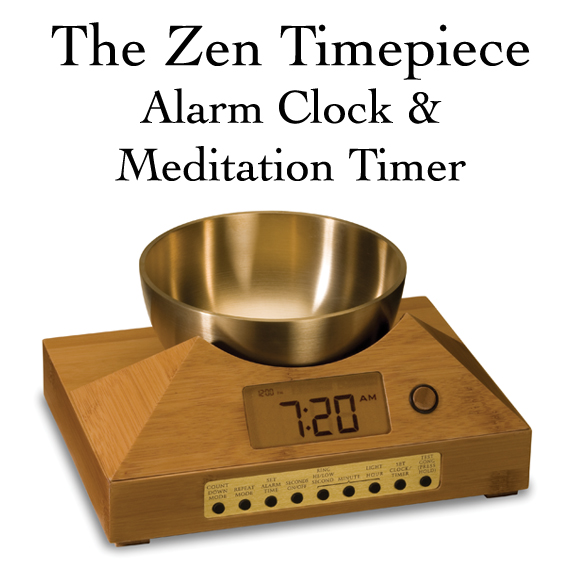 Gong Meditation Timer adapted from YogaJournal.com
Now & Zen – The Gong Meditation Timer Shop
1638 Pearl Street
Boulder, CO 80302
(800) 779-6383
Posted in Bamboo Chime Clocks
 monk Set aside half an hour.
Begin by calling to mind a sage or saint, or another human being you deeply admire. It should be someone you have a feeling for and whose teachings you understand—Jesus, or Buddha, Gandhi, St. Teresa of Avila, the Baal Shem Tov, or your own teacher, if that teacher has been a reliable example of enlightenment.
If no one comes to mind, choose one of the qualities of enlightened consciousness—such as compassion or love. Now, think deeply about that person or the quality you want to embody. Consider how it might be to look through that person’s eyes. If it’s a quality, ask yourself, “How would it be at this moment to look through the eyes of love?” Ask yourself, “How did this being treat others?” How might he or she behave while living your life? (Yes, what would Jesus do?) Imagine facing a challenge, a big conflict, the desertion of someone close. How would that person handle it?
Now, close your eyes and imagine that the spirit of that person (or that quality) inhabits your body. Inhale, thinking to yourself, “Christ’s love lives within me, as my love,” or “Buddha’s state of enlightenment is my enlightenment,” or “The courage of Gandhi is my courage.” Exhale, thinking, “That inner state fills my body.”
 Meditation Practice Do this for a few moments. Then ask yourself, “How would I move through the world if I truly embodied the qualities of this being? How would I treat myself? How would I be with my partner? my kids? my parents? the people on the bus? What would it be like to interact with others?”
Let your imagination completely open to this practice, imagining yourself enlightened, saturated with love. For the remainder of the half hour, act out of that experience. Be the great being you’re imagining yourself to be. Act out the quality you want to imbibe. Do this for half an hour a day for a week and see if you notice the effect.
Meditation is generally an inwardly oriented, personal practice, which individuals do by themselves. Meditation may involve invoking or cultivating a feeling or internal state, such as compassion, or attending to a specific focal point. The term can refer to the state itself, as well as to practices or techniques employed to cultivate the state. There are dozens of specific styles of meditation practice; the word meditation may carry different meanings in different contexts. Meditation has been practiced since antiquity as a component of numerous religious traditions. A 2007 study by the U.S. government found that nearly 9.4% of U.S. adults (over 20 million) had practiced meditation within the past 12 months, up from 7.6% (more than 15 million people) in 2002.
Although meditation can be done in almost any context, practitioners usually employ a quiet, tranquil space, a meditation cushion or bench, and some kind of timing device to time the meditation session. Ideally, the more these accoutrements can be integrated the better. Thus, it is conducive to a satisfying meditation practice to have a timer or clock that is tranquil and beautiful. Using a kitchen timer or beeper watch is less than ideal. And it was with these considerations in mind that we designed our digital Zen Alarm Clock and practice timer. This unique “Zen Clock” features a long-resonating acoustic chime that brings the meditation session to a gradual close, preserving the environment of stillness while also acting as an effective time signal. The Digital Zen Clock can be programmed to chime at the end of the meditation session or periodically throughout the session as a kind of sonic yantra. The beauty and functionality of the Zen Clock/Timer makes it a meditation tool that can actually help you “make time” for meditation in your life.
adapted from YogaJournal.com by Sally Kempton – an internationally recognized teacher of meditation and yogic philosophy and the author of The Heart of Meditation.
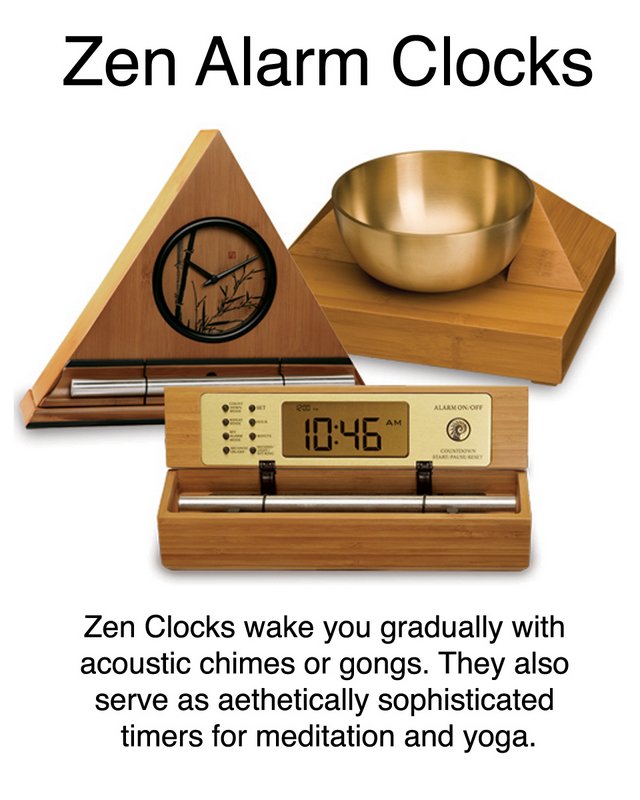 Choose a Chime or Gong Meditation Timer for Your Practice
Posted in Bamboo Chime Clocks
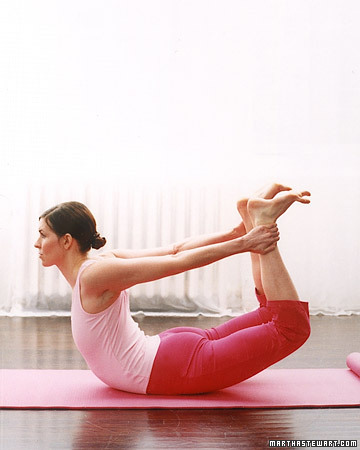 Bow Pose A morning yoga practice composed of the following poses can counter the fiery energy of the hot summer season. On its own or as part of our Ayurvedic weekend retreat, this series is designed to energize without overheating and can be done at home in as little as 30 minutes.
Lie face down, hands by your sides, palms facing up, legs together. Bending at the knees, bring your heels as close to your buttocks as possible. Raise your head, keeping your chin on the floor, then reach back with your hands and grasp your ankles firmly. Pull with your legs and arms, raising your head, chest, knees, and thighs off the floor. Raise your clasped legs as high as possible, keeping the spine relaxed. Rest your entire body weight on your navel. Breathe in and slowly exhale. Hold for 5 to 10 breaths, then release. Repeat the pose two times.
adapted from Wholeliving.com
 Yoga Timer with Gentle Chime Now & Zen – The Yoga Timer Shop
1638 Pearl Street
Boulder, CO 80302
(800) 779-6383
Posted in Bamboo Chime Clocks
 set your alarm so you can enjoy a nap Author Cathleen Schine pays tribute to the many pleasures of daytime sleeping. Read her testimonial, then go catch 40 winks yourself.
by Cathleen Schine
Scientific research has finally caught up with the lifework of my family. For three generations, we have been exploring, questioning, experimenting, passing along our findings from parent to child. We are not neuroscientists or psychologists, like those who have come after us. We are simply…nappers. A nap, where I come from, is sacred.
Sometimes, after large and indulgent family meals, we nap communally, sharing sofas head to foot, curled in chairs and sprawled, beside the dog and one another, on the floor. We firmly believe that no gathering can be deemed a success unless it culminates in every single person falling asleep in the living room.
Mostly, however, we understand the nap to be an endeavor embarked on alone, though often recounted later in every detail, like a Homeric epic tale, to eager listeners. My mother calls to tell me how pretty the light looked through the curtains when she came home from work. Of course, she had to sink into the couch and take a nap. My brother describes a snooze in his red chair with a book and Chester the cat. In the way that some people never suffer from a cold but always have a “terrible” cold, in the way that rain in California is never rain but “torrential” rain, naps for my family are never naps but “delicious” naps.
Oddly, the new scientific nap studies do not mention “delicious” naps. Their focus is on the practical use of these short bouts of sleep and the benefits they bestow on us, as if they were fiber-rich food. Scientists have found that naps make us more alert and more creative, improve our mood, and increase our productivity. Matthew Walker, an assistant professor of psychology at the University of California at Berkeley, was quoted by theNew York Times as saying, “You need to sleep before learning, to prepare your brain, like a dry sponge, to absorb new information.”
Although my brain often feels like a dry sponge, the one you find under the kitchen sink, way back next to the jar of desiccated silver polish, I cannot endorse this utilitarian interpretation of the nap.
I am gratified to know that a Harvard Medical School study showed that a 45-minute nap improves learning and memory, and I am relieved to discover that a 26-minute nap in flight enhanced a pilot’s performance by 34 percent and overall alertness by 54 percent (his copilots manned the controls, so don’t worry). The biphasic sleep schedule (which involves taking a nap in addition to sleeping at night) may help us move information from the hippocampus to the prefrontal cortex, where it becomes part of our long-term memory.
This is all to the credit of the nap, which I am prepared to celebrate in every way possible. But where, in these studies, is the joy? The romance? The cool, smooth surface of the white pillowcase? The light seeping gently through the white curtains? The slow inhalation of that clean, laundered scent? Where, indeed, in these studies, is the light itself?
A nap is not a nap without light. This is what distinguishes it from a good night’s sleep. A nap is a stolen moment, not the natural culmination of the day. A nap is secret, illicit. It is sleeping during the day, and the day must be present and visible. There must be light—ideally dappled in a garden or slanted through a window: soft and filtered and gentle. An afternoon sleep in a darkened room is not a nap, in my opinion. It is a migraine.
In fact, the best night’s sleep I ever had was on a trip to Norway, just near the Arctic Circle, in the summer. The sun never set, and I was able to “nap” all night.
 Enjoy a good nap Researchers suggest that naps are exceedingly effective in clearing our minds so we can fill them up again, and though I object to evaluating a nap solely in terms of its “effectiveness,” I would say that afternoons have the best napping light—when the sun seems to settle into a soft, deep repose. I don’t think a nice midmorning snooze should be devalued, however.
After a night of insomnia, after watching the milky pale light of dawn appear around the edges of the window shades, after hearing the chatter of sparrows, to get out of bed at last and have a cup of coffee and read the paper and feel blissfully alone, and then, like a punch to the head, be overcome with fatigue and stumble back to bed, where the sheets and the pillowcase have become especially cool and inviting—this is, without a doubt, one of life’s unforgettable pleasures.
Which brings me to another distinction researchers have not yet made: the city nap versus the country/suburban nap. When I’m in my apartment in New York City and about to take an afternoon nap, I usually turn on the air conditioner. This muffles the world outside in a way that, as far as I’m concerned, is not necessary in a morning nap that follows a sleepless night but is extremely pleasant in the afternoon. The young men generously sharing their booming music through open car windows, the gym class bouncing basketballs on their way to the park—all of this is part of the city I love, but not part of a nap.
Outside the city, however, the window stays open. The sound of a distant dog barking, of a crow calling harshly from a high branch or a finch singing from a telephone pole, the wind rustling the leaves—this is the stuff of naps.
When my eldest son was very small, he had trouble falling asleep at night. It turned out he was worried that he might not wake up. He has always been a thoughtful person, and in this association of sleep and death, he had joined a long tradition: the Bible, Shakespeare, the Romantic poets. There is something about the oblivion of sleep that reminds us of death—or at least what we think (or worry or, at times, even hope) death might be like. Naps are different: They are not weighted with the profound. Naps float, weightless and temporal, nature’s whims.
I was thrilled to read about the importance of naps in the formation of memory, and I’m grateful for the scientific work being done in this area. But thinking of that little boy pondering the inevitable and the unknowable, I was even more grateful for a family legacy that taught me, and allowed me to teach him, that not everything has to be useful, not everything has to lead to something more—that sometimes, for no reason and with no purpose, you can just curl up on the couch, feel the soft breeze, and drift into a soft, delicious sleep that leads to nowhere in particular, and back again. Remember to set you gentle chime alarm so that you nap can end calmly.
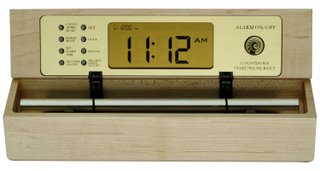 soothing chime alarms, a great tool for napping About the Author
Cathleen Schine is the author of eight novels, including The New Yorkers, The Love Letter, Rameau’s Niece, and, most recently, The Three Weissmanns of Westport. She lives in New York City and Venice, California.
 chime alarm clock store, Boulder, Colorado Now & Zen Chime Alarm Headquarter Store
1638 Pearl Street
Boulder, CO 80302
(800) 779-6383
Posted in Bamboo Chime Clocks, Now & Zen Alarm Clocks, Progressive Awakening, sleep, Sleep Habits
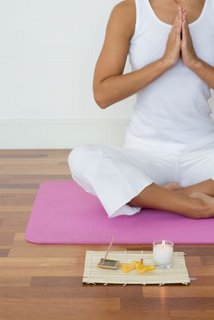 Take a Moment for Yourself When You Need a Moment…
Try a Sitting Meditation
To recenter your mind and body, sit on the floor in a comfortable position with a straight back. Set Your Zen Timepiece to repeat every 10 seconds. Inhale for ten seconds, then smoothly exhale for ten more. Repeat for at least three minutes and increase to 20 minutes as you improve.
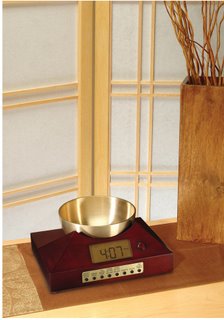 Set Your Singing Bowl Alarm to Repeat Every 10 Seconds
Posted in Bamboo Chime Clocks, Zen Timepiece by Now & Zen, Zen Timers
 Choki Eishosai, Sunrise at New Year It turns out that toddlers are not the only ones who do better after an afternoon nap. New research has found that young adults who slept for 90 minutes after lunch raised their overall learning power, their memory apparently primed to absorb new facts.
Other studies have indicated that sleep helps consolidate memories after cramming, but the new study suggests that sleep can actually restore the ability to learn.
The findings, which have not yet been published, were presented Sunday at the annual meeting of the American Association for the Advancement of Science in San Diego.
“You need to sleep before learning, to prepare your brain, like a dry sponge, to absorb new information,” said the lead investigator, Matthew P. Walker, an assistant professor of psychology and neuroscience at the University of California, Berkeley.
The study recruited 39 healthy young adults and divided them into two groups. All 39 were asked to learn 100 names and faces at noon, and then to learn a different set of names and faces at 6 p.m. But 20 of the volunteers who slept for 90 minutes between the two overall learning sessions improved their scores by 10 percent on average after sleeping; the scores of those who didn’t nap actually dropped by 10 percent.
Set your Zen Alarm Clock in your office and take a little snooze so that you can prime your brain for the best overall learning experience.
adapted from The New York Times, February 2010 by Roni Caryn Rabin
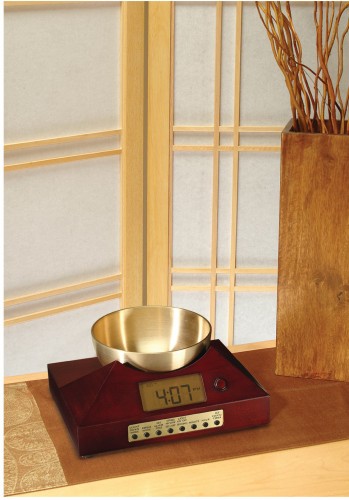 Zen Timepiece, an alarm clock to wake one from napping with Tibetan bowl/gong Now & Zen
1638 Pearl Street
Boulder, CO 80302
Posted in Bamboo Chime Clocks, Chime Alarm Clocks, Japanese Inspired Zen Clocks, Natural Awakening, Now & Zen Alarm Clocks, Progressive Awakening, Sleep Habits, Well-being
« Previous Page — « Previous Entries
Next Entries » — Next Page »
|
|
|
|